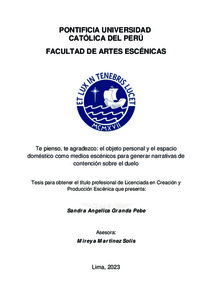| dc.contributor.advisor | Martinez Solis, Mireya | |
| dc.contributor.author | Granda Pebe, Sandra Angelica | |
| dc.date.accessioned | 2023-06-20T01:04:52Z | |
| dc.date.available | 2023-06-20T01:04:52Z | |
| dc.date.created | 2023 | |
| dc.date.issued | 2023-06-19 | |
| dc.identifier.uri | http://hdl.handle.net/20.500.12404/25228 | |
| dc.description.abstract | La presente tesis muestra los resultados de un laboratorio práctico realizado con tres
performers de la Pontificia Universidad Católica del Perú, con sus objetos personales y el
espacio doméstico como medios escénicos para generar narrativas de contención sobre el
duelo. La metodología utilizada se basa en el desarrollo del laboratorio práctico, el cual tiene
una duración de dos meses y se divide en tres módulos de sesiones grupales e individuales.
Este espacio prioriza ser un lugar seguro, horizontal y de contención para las participantes. El
proceso concluye con una muestra cerrada en la cual se presentan los hallazgos más
significativos. Además, durante esos meses, las performers y la guía trabajan con bitácoras
virtuales. Ello en conjunto ayuda a identificar y comprender las narrativas, las cuales dejan
ver que no se quedan solo en la vivencia dolorosa, sino que las performers pueden
transformarlas, resignificarlas e identificar nuevos recursos con el fin de compartirlas desde
maneras cuidadosas y amables para ellas. Según esto, el rol de la casa y de los objetos
personales es fundamental, pues el trabajo con ellos a través de las artes escénicas nos
muestra los secretos que contienen, desarrolla vínculos y significados que se transforman
continuamente, y con ello, se generan narrativas que nos permitan percibir el proceso de
duelo desde miradas diversas. Por ejemplo, los matices de las personas que trascienden y los
que se quedan, la decisión de cómo queremos recordar a nuestro ser querido, las reflexiones
sobre la contención con nosotros y los demás al vivenciar un duelo, y la transformación de
espacios u objetos como el armario. El cual, en un inicio, se siente como las puertas del
infierno o de la vulnerabilidad y luego se convierte en un lugar acogedor, seguro y que abriga
recuerdos muy preciados. | es_ES |
| dc.description.abstract | This thesis shows the results of a practical laboratory carried out with three performers from
the Pontifical Catholic University of Peru (PUCP), with their personal objects and the
domestic space as scenic means to generate narratives of contention about grief. The
methodology used is based on the development of the practical laboratory, which lasts two
months and is divided into three modules of group and individual sessions. This space
prioritizes being a safe, horizontal and supportive place for the participants. The process
concludes with a closed show in which the most significant findings are presented. In
addition, during these months, the performers and the guide work with virtual logs. This
together helps to identify and understand the narratives, which show that they do not remain
only in the painful experience, but that the performers can transform them, re-signify them
and identify new resources in order to share them in a careful and kind way for them.
According to this, the role of the house and personal objects is fundamental, since working
with them through the performing arts shows us the secrets they contain, develops links and
meanings that are continuously transformed, and with this, narratives are generated that allow
us to perceive the grieving process from different points of view. For example, the nuances
of the people who transcend and those who remain, the decision of how we want to
remember our loved one, the reflections on the containment with ourselves and others when
experiencing a mourning, and the transformation of spaces or objects such as the closet.
Which, at the beginning, feels like the gates of hell or vulnerability and then becomes a cozy,
safe place that shelters very precious memories. | es_ES |
| dc.language.iso | spa | es_ES |
| dc.publisher | Pontificia Universidad Católica del Perú | es_ES |
| dc.rights | info:eu-repo/semantics/openAccess | es_ES |
| dc.rights.uri | http://creativecommons.org/licenses/by/2.5/pe/ | * |
| dc.subject | Artes escénicas--Investigaciones | es_ES |
| dc.subject | Duelo | es_ES |
| dc.subject | Artistas | es_ES |
| dc.title | Te pienso, te agradezco: el objeto personal y el espacio doméstico como medios escénicos para generar narrativas de contención sobre el duelo | es_ES |
| dc.type | info:eu-repo/semantics/bachelorThesis | es_ES |
| thesis.degree.name | Licenciado en Creación y Producción Escénica | es_ES |
| thesis.degree.level | Título Profesional | es_ES |
| thesis.degree.grantor | Pontificia Universidad Católica del Perú. Facultad de Artes Escénicas | es_ES |
| thesis.degree.discipline | Creación y Producción Escénica | es_ES |
| renati.advisor.orcid | https://orcid.org/0000-0002-9716-4188 | es_ES |
| renati.advisor.pasaporte | G10336335 | |
| renati.author.dni | 75889227 | |
| renati.discipline | 215096 | es_ES |
| renati.juror | Medina Hu, Lucero Caroll | es_ES |
| renati.juror | Martinez Solis, Mireya | es_ES |
| renati.juror | Bejar Miranda, Marissa Violeta | es_ES |
| renati.level | https://purl.org/pe-repo/renati/level#tituloProfesional | es_ES |
| renati.type | https://purl.org/pe-repo/renati/type#tesis | es_ES |
| dc.publisher.country | PE | es_ES |
| dc.subject.ocde | https://purl.org/pe-repo/ocde/ford#6.04.04 | es_ES |







